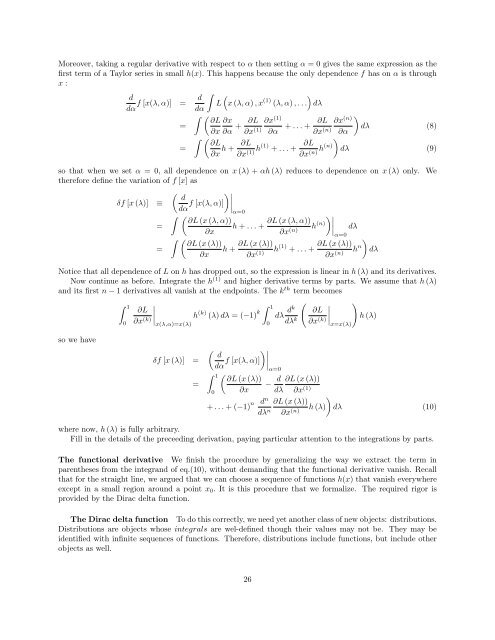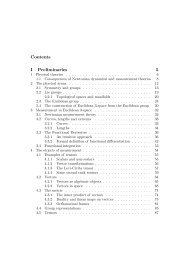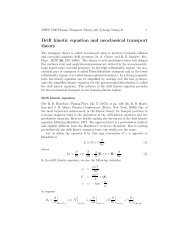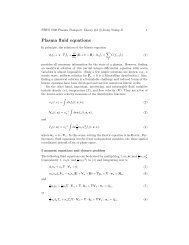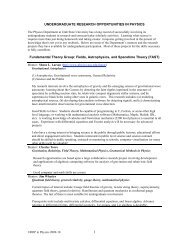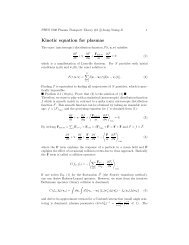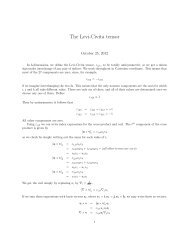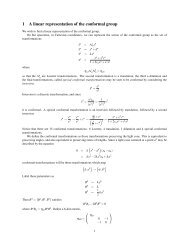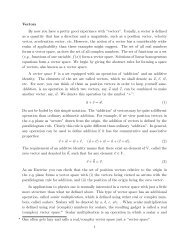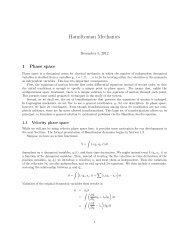Wheeler, Mechanics
Wheeler, Mechanics
Wheeler, Mechanics
You also want an ePaper? Increase the reach of your titles
YUMPU automatically turns print PDFs into web optimized ePapers that Google loves.
Moreover, taking a regular derivative with respect to α then setting α = 0 gives the same expression as the<br />
first term of a Taylor series in small h(x). This happens because the only dependence f has on α is through<br />
x :<br />
d<br />
d<br />
f [x(λ, α)] =<br />
dα dα<br />
=<br />
=<br />
∫<br />
(<br />
)<br />
L x (λ, α) , x (1) (λ, α) , . . . dλ<br />
∫ ( ∂L ∂x<br />
∂x ∂α +<br />
∫ ( ∂L<br />
∂x h +<br />
∂L ∂x (1)<br />
∂x (1) ∂α + . . . + ∂L ∂x (n) )<br />
dλ (8)<br />
∂x (n) ∂α<br />
∂L<br />
∂x (1) h(1) + . . . +<br />
∂L )<br />
∂x (n) h(n) dλ (9)<br />
so that when we set α = 0, all dependence on x (λ) + αh (λ) reduces to dependence on x (λ) only.<br />
therefore define the variation of f [x] as<br />
We<br />
δf [x (λ)]<br />
≡<br />
=<br />
=<br />
( )∣ d<br />
∣∣∣α=0<br />
dα f [x(λ, α)]<br />
∫ ( ∂L (x (λ, α))<br />
h + . . . +<br />
∂x<br />
∫ ( ∂L (x (λ))<br />
h +<br />
∂x<br />
)∣<br />
∂L (x (λ, α)) ∣∣∣α=0<br />
h (n) dλ<br />
∂x (n)<br />
)<br />
∂L (x (λ))<br />
h (1) ∂L (x (λ))<br />
+ . . . + h n dλ<br />
∂x (1)<br />
∂x (n)<br />
Notice that all dependence of L on h has dropped out, so the expression is linear in h (λ) and its derivatives.<br />
Now continue as before. Integrate the h (1) and higher derivative terms by parts. We assume that h (λ)<br />
and its first n − 1 derivatives all vanish at the endpoints. The k th term becomes<br />
∫ 1<br />
∣ ∫ (<br />
∂L ∣∣∣x(λ,α)=x(λ) 1<br />
∣ )<br />
h (k) (λ) dλ = (−1) k dλ dk ∂L ∣∣∣x=x(λ)<br />
∂x (k) dλ k h (λ)<br />
∂x (k)<br />
so we have<br />
0<br />
0<br />
δf [x (λ)] =<br />
=<br />
( )∣ d<br />
∣∣∣α=0<br />
dα f [x(λ, α)]<br />
∫ 1<br />
( ∂L (x (λ))<br />
− d ∂L (x (λ))<br />
0 ∂x dλ ∂x (1)<br />
+ . . . + (−1) n d n<br />
)<br />
∂L (x (λ))<br />
dλ n h (λ) dλ (10)<br />
∂x (n)<br />
where now, h (λ) is fully arbitrary.<br />
Fill in the details of the preceeding derivation, paying particular attention to the integrations by parts.<br />
The functional derivative We finish the procedure by generalizing the way we extract the term in<br />
parentheses from the integrand of eq.(10), without demanding that the functional derivative vanish. Recall<br />
that for the straight line, we argued that we can choose a sequence of functions h(x) that vanish everywhere<br />
except in a small region around a point x 0 . It is this procedure that we formalize. The required rigor is<br />
provided by the Dirac delta function.<br />
The Dirac delta function To do this correctly, we need yet another class of new objects: distributions.<br />
Distributions are objects whose integrals are wel-defined though their values may not be. They may be<br />
identified with infinite sequences of functions. Therefore, distributions include functions, but include other<br />
objects as well.<br />
26


